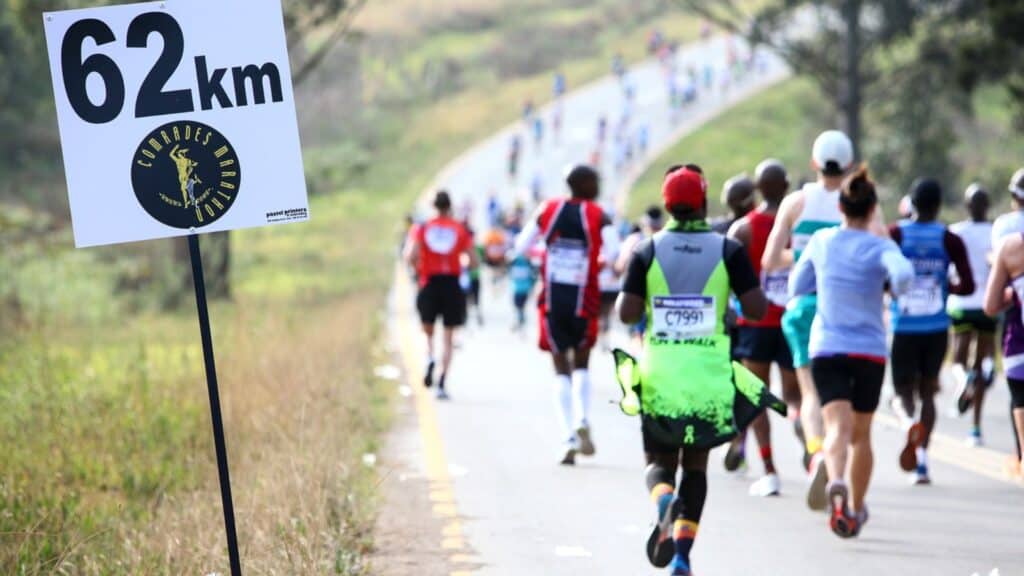The Comrades Marathon is one of the most challenging and prestigious ultra-marathons in the world, testing both your mental and physical endurance.
If you’re an experienced marathoner or athlete, training for this event can be a daunting task.
But what if you don’t have access to trails, mountains, or long open roads? Is it possible to train for the Comrades Marathon on a treadmill?
In this post, we’ll explore whether it’s possible and how to go about it. So, let’s get started…

Is It Possible To Train For The Comrades Marathon On a Treadmill?
The treadmill is an excellent option for runners looking to train in a controlled environment.
With proper planning and execution, you can certainly train for the Comrades Marathon on a treadmill.
A treadmill provides consistent pacing, which can be helpful in controlling your speed and endurance. However, there are a few things you should keep in mind.
Firstly, your training program on the treadmill should be varied, as your body can quickly adapt to the same routine, leading to slower progress. Focus on increasing your duration and speed gradually. Introduce hill simulations, intervals, and tempo runs to simulate the demands of running on varied terrain.
Secondly, your biomechanics on the treadmill will be different from running outdoors. The treadmill belt propels you forward, causing your feet and legs to behave differently. To simulate outdoor running, set your treadmill at a 1% incline to help counter this mechanical deviation.
Thirdly, mental preparation is important when running on a treadmill for longer periods of time. It can be monotonous and uninspiring. To break the boredom, include an upbeat playlist of your favorite music or listen to a motivating podcast. Another option is to run with a virtual training partner.
Additionally, while training on a treadmill, ensure that you listen to your body. Rest, nutrition, and hydration are critical components of your training. They help you to recover and maximize your training benefits.
In the following sections, we’re going to cover in-depth your Comrades Marathon treadmill training. But before that, let’s look at why you might want to think about training for the Comrades Marathon on a treadmill.

Why Training For Comrades Marathon On A Treadmill Is Beneficial
There is no denying that the Comrades Marathon is one of the toughest ultra-marathons in the world. This gruelling race takes athletes from Pietermaritzburg to Durban, covering a distance of 90 km (55.9 miles).
The race requires months of training to prepare the body and mind for the challenge ahead.
But with busy schedules and other commitments, it can be challenging to find the time and motivation to train outdoors. That’s where treadmills come in.
Believe it or not, training for the Comrades Marathon on a treadmill has numerous benefits…
1. Convenience
Training for the Comrades Marathon requires a lot of time and dedication. Finding the time to run outdoors, especially during winter months, can be challenging. The treadmill is an excellent solution for runners who want to train indoors.
With the ability to customize your training experience, you can simulate the hills and terrain of the Comrades Marathon without leaving the comfort of your home or gym.
2. Controlled Environment
Running outdoors is unpredictable, and many factors can impact your training, such as weather, terrain, and traffic. Treadmill running allows you to control the training environment, reducing the risk of injury and making it easier to track your performance.
Additionally, you can customize your training, adjusting the incline and pace to align with your training program’s specific requirements.
3. Injury Prevention
The impact of running outdoors can put a lot of stress on your joints, especially as the distance and intensity of your training increases in preparation for the Comrades Marathon.
Treadmill running helps to reduce the impact by providing a softer running surface, reducing the risk of injury. Moreover, the controlled environment on a treadmill prevents distractions that can increase the risk of accidents.
4. Mental Preparation
The Comrades Marathon is a test of not just physical endurance but mental toughness. Treadmill training can help athletes prepare their minds for the Comrades pre-race ritual and push themselves through the mental barriers that come with the race.
The controlled and customizable environment of the treadmill allows runners to focus solely on their training, visualize success and stay motivated throughout their training journey.
5. Cross-Training
Cross-training is crucial for any athlete’s success, especially if you’re undertaking the Comrades Marathon.
Treadmill training provides a superb opportunity to incorporate cross-training activities, such as strength training and stretching routines, into your training regimen.
The treadmill can be set to various intensity levels that simulate the intensity of other cross-training activities, such as hill sprints, ensuring that you can keep your body conditioned for the race.
6. Reduced risk of injury
Speaking of injuries, training for the Comrades Marathon on a treadmill is safer than training outdoors. The padded surface of the treadmill reduces the impact on your joints, reducing the risk of injuries such as shin splints and stress fractures. The controlled nature of the machine also allows you to maintain a more constant cadence and gait, reducing the likelihood of overuse injuries such as plantar fasciitis.
7. Mental toughness
One of the most significant benefits of training on a treadmill is the development of mental toughness. Anyone who has run on a treadmill knows that it requires a whole different level of focus and determination than running outside.
By training on a machine, you will develop the mental toughness required to push yourself to your limits and beyond. This mental strength will come in handy during the Comrades Marathon, where you will encounter numerous challenges that require an unbreakable mindset to overcome.
8. Safety
With outdoor terrain, there’s a real risk of injury due to the environment, unpredictable weather, or wild animals. By incorporating treadmill training for the Comrades Marathon, you’re ensuring your safety throughout the entire preparation process.
No more worrying about twisted ankles while handling rocky or uneven terrain.
9. Consistency
One of the main benefits of training on a treadmill is the consistency it provides. In the months leading up to the Comrades Marathon, consistency in training is essential.
A treadmill allows you to maintain your training schedule, regardless of the weather conditions, time of day, or your location. No more missed training sessions due to adverse weather or a busy schedule.
10. Improved performance
Finally, training for the Comrades Marathon on a treadmill can significantly improve your performance. Because you can control the environment, you can tailor your training sessions to suit your specific needs.
By increasing the incline, adjusting the speed, and replicating the terrain of the marathon course, you can build strength, endurance, and mental toughness, improving overall performance.

Treadmill Workouts For Comrades Marathon Training
As mentioned earlier, it’s crucial to keep your treadmill workouts varied. Doing the same routine all the time can slow down your progress because your body gets used to it.
A key tip is to gradually increase both your workout duration and speed. This way, you keep moving forward, reap the benefits, and most importantly, minimize the risk of injuries.
Grab your Comrades Marathon Training Plan here!
Longs Runs
Long runs are a big part of your training plan. They help boost your endurance, making your body better at handling longer distances, both physically and mentally.
When doing long runs on a treadmill, here’s what you should keep in mind:
Stick to the pace suggested in your training plan, but add a 1% incline to the treadmill.
Remember, treadmill models can be different, so focus more on how hard you’re working instead of exact measurements.
Keep it at an easy effort level to ensure a good workout without relying too much on external measurements.
Interval Training & Hill Intervals
Interval training and hill intervals are very effective ways to improve your endurance, speed, and overall running skills.
Interval training means switching between rest and intense running, while hill intervals focus on building muscle and cardio strength by adding inclines to your run.
Hill repeats mean running uphill at a challenging pace for a set time and downhill at a relaxed pace, as recommended in your training plan. The pace guideline is how hard you should tackle the uphill part.
For the downhill, don’t worry too much about timing. Even if you naturally slow down, it’s crucial not to take much longer than suggested.
Going downhill is like active recovery, letting you catch your breath for the next uphill run. Balancing this is key to a good workout.
It’s a good idea to stick to a reasonable time range for the descent. This keeps you at a good pace and ensures enough recovery before the next uphill run.
When doing interval training on a treadmill, keep the incline at 0% for most intervals. For hill intervals, gradually increase the incline to 3-5% as you get better.
Adjust the difficulty to challenge yourself, and it’s totally okay to slow down if it feels too tough.
Before you start, make sure to warm up properly. This includes easy running, builds, strides, and running drills. You can also throw in some dynamic stretching.
For intense sessions like intervals or hill runs, spend 15–20 minutes warming up. But for easy or recovery runs, 5-10 minutes of a gentle warm-up is usually enough before you get into your groove.
Understanding these details about hill repeats is crucial for getting the most out of your marathon training. By focusing on the recommended uphill effort and keeping the descent in check, you’ll boost your strength, endurance, and overall performance for race day.
Time Trials
Time trials are important checkpoints in your training, helping you track progress and tweak your plan if needed. Usually done every four to six weeks, these trials show how you’re doing and give insights into your improvement.
Depending on your race goal, time trials can be 5 miles or 8 km. Give your best effort during these to get an accurate idea of your abilities.
When doing time trials on a treadmill, set the incline to 1%. This slight incline mimics outdoor conditions, giving you a truer picture of your performance.
How To Properly Hydrate And Fuel On Treadmill Marathon Training
Stay hydrated
It can be easy to forget to drink water while you’re running on a treadmill, especially if you’re used to running outdoors and have access to water fountains. But it’s crucial to stay hydrated, as dehydration can lead to fatigue, muscle cramps, and even heat exhaustion.
Be sure to bring a water bottle with you and take sips throughout your run. It’s also helpful to drink electrolyte-rich sports drinks to replenish sodium and potassium lost through sweat.
Fuel Up Before Your Run
Eating the right foods before your workout can give you the energy you need for a successful run. Aim to eat a meal rich in carbohydrates and protein about 2-3 hours before your run.
This could be a bowl of oatmeal with nuts and fruit, a peanut butter and jelly sandwich, or a veggie-packed omelette. Make sure to avoid foods that are high in fat or sugar, as they can cause digestive distress during your run.
Snack On The Go
During your marathon training, you’ll likely be running for long periods of time, so you need to refuel along the way.
Bring healthy snacks with you, such as energy bars, gels, or fruit. Be sure to choose high-carb snacks that are easy to digest, as it will be important to maintain your energy levels during the run.
Plan For Your Post-Run Meal
After a long run, your body needs to replenish the nutrients it lost. Plan to eat a meal within 30 minutes of finishing your run that includes protein, carbohydrates, and healthy fats.
This could be a turkey and avocado sandwich, a quinoa and veggie stir-fry, or a salmon salad. Avoid high-fat or high-sugar meals, as they can slow down your recovery.
If eating solid food feels challenging, think about going for a liquid option like chocolate milk. It’s a simple and efficient way to kick-start your recovery.
Research shows that chocolate milk can be a budget-friendly and effective substitute for pricier recovery products. It helps extend the time you can train and boosts muscle repair, both of which are crucial for recovering after a workout.
Listen To Your Body
Every runner is different, and what works for one person may not work for another. Pay attention to how your body responds to hydration and nutrition during your treadmill marathon training. If you experience fatigue, cramps, or other symptoms, adjust your intake accordingly.

And don’t forget to rest when you need it! Getting enough sleep and allowing your body to recover is just as important as hydrating and fueling properly.



Comments are closed.